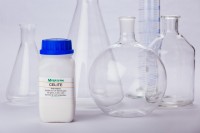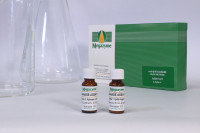| Content: | 5,000 Units |
| Shipping Temperature: | Ambient |
| Storage Temperature: | 2-8oC |
| Formulation: | In 3.2 M ammonium sulphate |
| Physical Form: | Suspension |
| Stability: | > 1 year under recommended storage conditions |
| Enzyme Activity: | endo-Polygalacturonase |
| EC Number: | 3.2.1.15 |
| CAZy Family: | GH28 |
| CAS Number: | 9032-75-1 |
| Synonyms: | polygalacturonase; (1→4)-alpha-D-galacturonan glycanohydrolase |
| Source: | Pectobacterium carotovorum |
| Molecular Weight: | 39,818 |
| Concentration: | Supplied at ~ 14,000 U/mL |
| Expression: | Recombinant from Pectobacterium carotovorum |
| Specificity: | Random hydrolysis of α-1,4-D-galactosiduronic linkages in pectate and polygalacturonans. |
| Specific Activity: | ~ 400 U/mg (40oC, pH 5.5 on polygalacturonic acid) |
| Unit Definition: | One Unit of endo-polygalacturonanase activity is defined as the amount of enzyme required to release one μmole of galacturonic acid from polygalacturonic acid (5 mg/mL) per min in sodium acetate buffer (100 mM), pH 5.5 at 40oC. |
| Temperature Optima: | 50oC |
| pH Optima: | 6 |
| Application examples: | Applications in carbohydrate research and in the food industry. |
High purity endo-Polygalacturonanase (Pectobacterium carotovorum) for use in research, biochemical enzyme assays and analytical testing applications.
Find all CAZy enzyme products on our list.
Discovery and characterization of an FAD-dependent glucose 6-dehydrogenase.
Fujii, T., Honda, M., Fujii, W., Shimada, Y., Takeuchi, M. & Ogawa, J. (2025). Journal of Biological Chemistry, 301(3), 108189.
Many patients with diabetes use self-measurement devices for blood glucose to understand their blood glucose levels. Most of these devices use FAD-dependent glucose dehydrogenase (FAD-GDH) to determine blood glucose levels. For this purpose, FAD-GDHs specifically oxidizing glucose among the sugars present in blood are required. Many FAD-GDHs with high substrate specificity have been reported previously; however, their substrate specificity is insufficient as they also react with xylose. Therefore, we aimed to identify FAD-GDHs without xylose reactivity. We screened and obtained a new enzyme from Colletotrichum plurivorum (CpGDH). CpGDH showed high activity to glucose in the presence of electron mediators but low activity to xylose. We prepared the glucose oxidation products using CpGDH and subjected to TLC, HPLC, mass spectrometry, and NMR analyses. The results demonstrated that CpGDH is a previously unknown FAD-dependent glucose 6-dehydrogenase (FAD-G6DH) that oxidizes glucose to glucuronic acid. The stoichiometric ratio of the substrate and electron mediator was 1:2, suggesting that CpGDH catalyzes two-step oxidation reactions, including oxidation of primary alcohols to aldehydes and of aldehydes to carboxylic acids. We concluded that CpGDH has the unique substrate-binding manner based on the result of docking simulation of CpGDH with a substrate glucose. We then constructed a phylogenetic tree of carbohydrate-related flavoproteins including FAD-G6DHs, indicating that FAD-G6DHs are different from the known FAD-dependent oxidoreductases. Overall, this study is the first to report FAD-G6DHs. These results will likely contribute to the development of more accurate blood glucose sensors and further research on the metabolisms of glucosides and their metabolites.
Hide AbstractGelation behavior between Nicandra physalodes (Linn.) Gaertn. pectin and Ca2+ is governed by degree and pattern of methylesterification.
Zhang, H., Song, Z., Gong, T., Meng, Y., Wang, X., Zhang, S. & Guo, Y. (2024). Food Hydrocolloids, 149, 109640.
Nicandra physalodes (Linn.) Gaertn. Pectin (NPGP) is a new type of natural low methoxy pectin (LMP), however, the relatively poor gelling capacity of NPGP and neutral calcium limits its applicability in the food industry. In this study, we improved the gelling capacity of NPGP, and the impact of the degree and pattern of methyl esterification on NPGP gelation behavior triggered by neutral calcium was investigated. To achieve this goal, NPGP was treated with pectin methyl esterase (PME, 30°C, pH 4.5) for various time. This modification decreased the degree of methyl esterification (DM) and generated different patterns of methyl ester distribution, quantified as the degree of blockiness (DB). The obtained PME-NPGPs possess the ability to form self-supporting gels in the presence of CaCl2, with the highest gel hardness being 331.98 g. By estimating the DM and quantifying the DB of PME-NPGP, the DB value of PME-NPGP was increased from 17.74% to 31.84% with DM decreasing from 33.09% to 17.37%, indicating a shift toward a more blockwise distribution of nonmethylated GalA in NPGP. Additionally, adsorption isotherms for Ca2+ on de-esterified NPGP were determined, enabling the quantification of its cation binding capacity and interaction energy. Reducing DM and increasing DB of NPGP were found to enhance NPGP's binding capacity to Ca2+. This research provides an important foundation for NPGP food processing, and the obtained PME-NPGP can be promising in the fields of food gel and drug delivery.
Hide AbstractThe model polysaccharide potato galactan is actually a mixture of different polysaccharides.
Feng, Z., Lin, Z., Tang, H., Geng, J., Hu, Y., Mayo, K. H., Tai, G. & Zhou, Y. (2023). Carbohydrate Polymers, 313, 120889.
Commercially-supplied potato galactan (PG) is widely used as a model polysaccharide in various bioactivity studies. However, results using this galactan are not always consistent with the stated composition. Here, we assessed its composition by fractionating this commercial PG and purified its primary components: PG-A, PG-B and PG-Cp with weight-averaged molecular weights of 430, 93, and 11.3 kDa, respectively. PG-Cp consists of free β-1,4-galactan chains, whereas PG-A and PG-B are type I rhamnogalacturonans with long β-1,4-galactan side chains of up to 80 Gal residues and short β-1,4-galactan side chains of 0 to 3 Gal residues that display a “trees in lawn” pattern. Structures of these polysaccharides correlate well with their activities in terms of galectin-3 binding and gut bacterial growth assays. Our study clarifies the confusion related to commercial PG, with purified fractions serving as better model polysaccharides in bioactivity investigations.
Hide AbstractMUR1‐mediated cell‐wall fucosylation is required for freezing tolerance in Arabidopsis thaliana.
Panter, P. E., Kent, O., Dale, M., Smith, S. J., Skipsey, M., Thorlby, G., Cummins, I., Ramsey, N., Begum, R. A., Sanhueza., Fry, S. C., Knight, M. R. & Fry, S. C. (2019). New Phytologist, 224(4), 1518-1531.
Summary: Forward genetic screens play a key role in the identification of genes contributing to plant stress tolerance. Using a screen for freezing sensitivity, we have identified a novel freezing tolerance gene, SENSITIVE‐TO‐FREEZING8, in Arabidopsis thaliana. We identified SFR8 using recombination‐based mapping and whole‐genome sequencing. As SFR8 was predicted to have an effect on cell wall composition, we used GC‐MS and polyacrylamide gel electrophoresis to measure cell‐wall fucose and boron (B)‐dependent dimerization of the cell‐wall pectic domain rhamnogalacturonan II (RGII) in planta. After treatments to promote borate‐bridging of RGII, we assessed freeze‐induced damage in wild‐type and sfr8 plants by measuring electrolyte leakage from freeze‐thawed leaf discs. We mapped the sfr8 mutation to MUR1, a gene encoding the fucose biosynthetic enzyme GDP‐d‐mannose‐4,6‐dehydratase. sfr8 cell walls exhibited low cell‐wall fucose levels and reduced RGII bridging. Freezing sensitivity of sfr8 mutants was ameliorated by B supplementation, which can restore RGII dimerization. B transport mutants with reduced RGII dimerization were also freezing‐sensitive. Our research identifies a role for the structure and composition of the plant primary cell wall in determining basal plant freezing tolerance and highlights the specific importance of fucosylation, most likely through its effect on the ability of RGII pectin to dimerize.
Hide Abstract






















